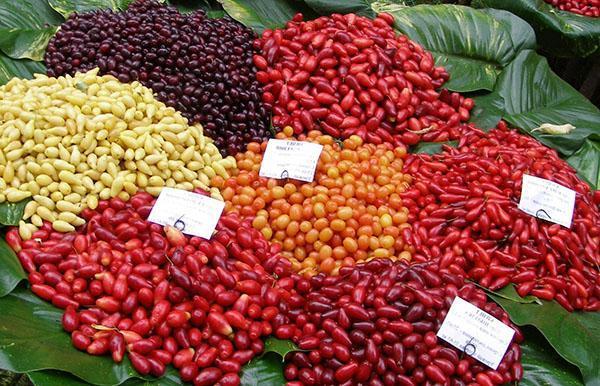We grow only cultivated varieties of dogwood
 It seems to many that this adorable shrub is not adapted to life in the northern regions. However, breeders have bred dogwood cultivars that are capable of withstanding up to -30 ° C. Moreover, their bloom is also not afraid of frost.
It seems to many that this adorable shrub is not adapted to life in the northern regions. However, breeders have bred dogwood cultivars that are capable of withstanding up to -30 ° C. Moreover, their bloom is also not afraid of frost.
Fruits on such plants ripen by the end of August and flaunt on the branches until early October. The timing depends largely on the variety.
Saplings begin to bear fruit only 4-5 years after planting. The peduncles of the tree are not self-pollinated, therefore it is advised to plant 2-3 copies nearby.
Dogwood cultivars are better than wild ones
Fraud is a hallmark of modern society. Since there are so many varieties of this bush, half of them still belong to wild crops. Therefore, gardeners need to be able to identify fruits that fall into each of these two categories. The main distinguishing feature between them is color and size. Cultural varieties of dogwood have berries:
- dark red, black, yellow or orange;
- large dimensions;
- oval or round.
The plant lends itself well to crown formation. If it is properly budded or properly pruned, then you can get a compact bush or a miniature tree. Fruits on such a scion will appear after 2-3 years.
It is propagated exclusively by budding, but not by grafting. In the first case, survival is guaranteed by 70%, and in the second - 10-15%.
Semi-cultivated species are not royal
Many gardeners are faced with the problem that seedlings do not take root in their area. This is often caused by the weather conditions of a particular region. In this situation, it is necessary to plant seeds of varietal plants in order to obtain a specimen that is adaptable to the climatic anomalies of the region.
Dive seedlings are transferred in the spring to open ground. Then the strongest and most fertile seedlings are chosen from them, and then they painstakingly look after them. Thus, the farmer transforms from a gardener to an amateur breeder.
First, bones (from 10 pcs.) Are naturally stratified. It is placed in a moist substrate and left for several months in a cool room (within 2-5 ° C). Before that, it is recommended to press them down a little so that the shell cracks, thereby providing the sprout with easy germination.
Hybrid dogwood varieties differ from cultivated varieties in smaller berries and fruiting times. Yet, like their predecessors, they cannot stand the scorching sun, so the plants are planted in shady areas.